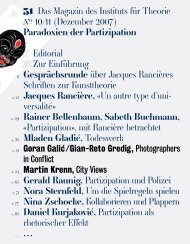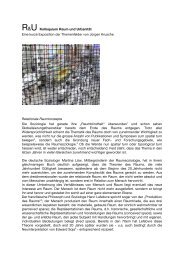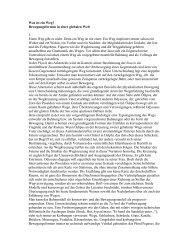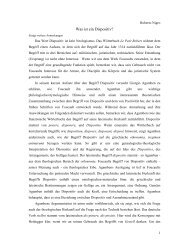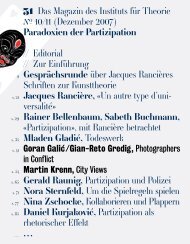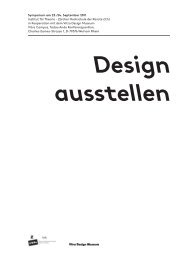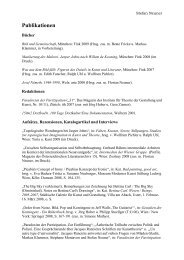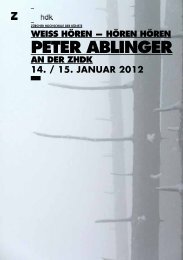Heft - Institut für Theorie ith
Heft - Institut für Theorie ith
Heft - Institut für Theorie ith
Sie wollen auch ein ePaper? Erhöhen Sie die Reichweite Ihrer Titel.
YUMPU macht aus Druck-PDFs automatisch weboptimierte ePaper, die Google liebt.
Mladen<br />
Dollar<br />
87<br />
One<br />
Splits<br />
into<br />
Two<br />
There is a problem which has haunted<br />
the whole history of psychoanalysis,<br />
namely whether the goal of analysis<br />
should ultimately be the integration<br />
into the symbolic of what is recalcitrant<br />
to it, thus the integration of the unconscious,<br />
censured chapter of one’s history<br />
into the universe of meaning, in<br />
order to make sense of it and eventually<br />
do away w<strong>ith</strong> it. For to interpret means<br />
to endow w<strong>ith</strong> meaning that which has<br />
defied meaning as an alien body, to<br />
arrive at the point where we are able to<br />
understand what the unconscious tries<br />
to say, to state in a straightforward<br />
manner what it was saying in a roundabout<br />
way; which would amount to<br />
remove it as the discourse of the Other,<br />
and hopefully live happily ever after.<br />
The second di≠erence of ineradicable<br />
alterity would thus be incorporated<br />
into the first di≠erence and would stop<br />
haunting us or determining us behind<br />
our back. Let’s make the unconscious<br />
conscious? Let’s integrate the two back<br />
into one? Is the aim of psychoanalysis<br />
to do away w<strong>ith</strong> its object and thus to<br />
make the analyst superfluous, to strive<br />
for his / her unemployment? To do<br />
away w<strong>ith</strong> the Other and reconcile it<br />
w<strong>ith</strong> One? To lift one’s alienation in a<br />
self-reflexive appropriation of the selfproduced<br />
and self-inflicted Other? But<br />
all this comes to nothing, for the basic<br />
tenet of psychoanalysis is rather that no<br />
such lifting is possible, and that the<br />
very notion of subjectivity pertains precisely<br />
to the impossibility of such selfappropriation.<br />
The subject is premised<br />
on “two.” One becomes the subject precisely<br />
in relation to an alien kernel<br />
w<strong>ith</strong>in the symbolic order that cannot<br />
be symbolically sublated. This makes<br />
the subject of the unconscious of a<br />
di≠erent nature than the ego. There is<br />
the Other which constitutes the inherent<br />
split of the two, the two not to be<br />
merged back into one. Although the otherness<br />
of the Other has no ontological<br />
7 - Lacan takes up “la coche” as<br />
the elementary function of the<br />
signifier, the mark, the cut,<br />
made by the primitive hunter<br />
to count the killed animals.<br />
He deals w<strong>ith</strong> this at length in<br />
the unpublished seminar on<br />
Identification (1961–1962).<br />
8 - See Sigmund Freud, “Massenpsychologie<br />
und Ich-Analyse,”<br />
in: id., Studienausgabe, 10 vol.,<br />
Alexander Mitscherlich u. a.<br />
(Hgg.), Frankfurt a. M.<br />
1969–1974, vol. 9, p. 100.<br />
9 - Jacques Lacan, Encore, Paris<br />
1975, p. 40.<br />
10 - Ibid., p. 65.<br />
11 - Ibid., p. 75.<br />
consistency, it nevertheless persists. It<br />
does not establish a separate Other of<br />
the Other, it persists solely w<strong>ith</strong>in the<br />
Other. So the bottom line would be:<br />
there is an irreducible two, an irreducible<br />
gap between the One and the Other,<br />
and the unconscious, at its minimal,<br />
presents the figure of the two, not to be<br />
sublated or fused into one. The problem<br />
here that remains is that, well, the<br />
Other does not exist.<br />
Where does this leave us w<strong>ith</strong> our question<br />
of counting? The symbolic, w<strong>ith</strong> its<br />
minimal signifying element which is<br />
counted for one, can always be submitted<br />
to a count, and it proceeds metonymically.<br />
Its mathematical formula<br />
could be (n + 1): for every signifier there<br />
is a (+ 1) signifier, always to be extended<br />
and continued. But the Other, which<br />
constitutes the two, as opposed to (n +<br />
1), cannot be counted. There is rather a<br />
(n – 1), a subtraction from the battery of<br />
signifiers which leaves like a hole in the<br />
system, a lack, a missing signifier, but<br />
which is always presentified by an<br />
excess, a surplus, but a surplus which is<br />
not of the order of (+ 1), not a numerical<br />
addition, a surplus which makes for the<br />
two which cannot be seen as another<br />
one. To put it another way: it is the signifier<br />
that enables counting, that makes<br />
possible that something can be counted<br />
for one. 7 It is the mark of the unitary<br />
trait Freud has called “ein einziger<br />
Zug.” 8 The signifying slip, however, is<br />
not countable, it is not in the register of<br />
the unitary trait, it points to the Other<br />
of counting and thus makes for the two.<br />
Yet the figure of the Other as the Other<br />
of language, structure, code, the symbolic<br />
order, is but one face of the Other.<br />
In Lacan we can read the following,<br />
which seems to confront us w<strong>ith</strong> a very<br />
di≠erent agenda: “The Other, in my<br />
parlance, cannot be anything else but<br />
the Other sex.” / “L’Autre, dans mon<br />
langage, cela ne peut donc être que<br />
l’Autre sexe.” 9 “The Other, if it may be<br />
one, must certainly have a relation to<br />
what appears as the other sex.” 10 “The<br />
Woman must be related to the signifier<br />
of this Other insofar as, as the Other, it<br />
can only remain always the Other.” 11 It<br />
appears now that the other face of the<br />
Other may well be the face of the woman,<br />
and that the Other is inherently and<br />
at the same time the Other of sex, of sex<br />
as the Other, sex under the auspices of<br />
the irreducible two. But not the two of<br />
count.<br />
If in the first instance it seemed that the<br />
Other is a highly disembodied entity,<br />
which has to do w<strong>ith</strong> signifiers and<br />
structures, then in this other aspect it<br />
an Other which sticks to the body, most<br />
intimately, and presents its rift. Not the<br />
rift of language, but the rift of our natural<br />
bodily being. This implies that the<br />
sexual di≠erence, if this is the name of<br />
this rift, is not a di≠erence that could be<br />
encompassed or covered or accounted<br />
for in terms of the signifying di≠erence,<br />
the di≠erence of Saussurean di≠erentiality,<br />
that is, in terms of One, its replication<br />
and its split. It does not present the<br />
two of counting, based on counting for<br />
one and then extending this count, it<br />
pertains to the “other” di≠erence which<br />
cannot be counted and stops at two,<br />
that is, at the di≠erence of the one and<br />
the Other. But according to the other<br />
part of our Lacanian antinomy, the<br />
Other lacks, it does not exist, it has no<br />
ontological consistency on its own, it<br />
rather marks the persistence of a di≠erence<br />
which eludes the series of signifying<br />
di≠erences and cannot be captured<br />
by them. Consequently, it would follow<br />
that the Other, as “the Other sex,” does<br />
not exist e<strong>ith</strong>er, and this is indeed the<br />
consequence drawn by Lacan’s notorious<br />
dictum, which caused so much havoc,<br />
that “the Woman doesn’t exist”. If<br />
the Other is the Other sex, this conclusion<br />
inevitably follows – but the trouble<br />
is that the non-existence does not make<br />
it vanish.<br />
There is an enigma which sticks to the<br />
very discovery of psychoanalysis. In his<br />
inaugurational three books Freud presented<br />
the unconscious as the new<br />
object of the new science, something<br />
that can be summed up by the Lacanian<br />
dictum “the unconscious structured<br />
like a language,” that is, like a derailment<br />
of language, its constant slippage.<br />
Then in 1905 he published the Three<br />
Essays on the Theory of Sexuality, a<br />
surprising work in respect of the first<br />
three books. For the focus of this new<br />
book is not the language and its vicissitudes<br />
– there is rather an astounding<br />
absence of any linguistic considerations<br />
–, but the body and its vicissitudes, its<br />
deviations from natural needs and from<br />
natural maturation. It is not the body of<br />
firm substance and natural causality,<br />
the physiological body, Freud analyzes<br />
but a body haunted by a cut, and it is<br />
this cut into the physiological causality<br />
that conditions and produces the drives.<br />
It is both an epistemological cut, sorting<br />
out the inside / outside divide and<br />
the transition between the two, and at



